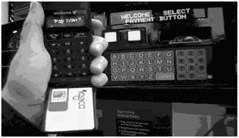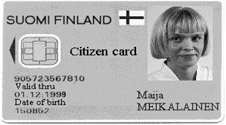Equipment Used in M-Commerce
|
This is an overview of the equipment necessary to conduct m-commerce. It consists of digital cellular phones, smart cards, laptop or palmpads, and the software to operate and communicate with this hardware.
Digital Cellular Phones
Dual-slot mobile phone technology was developed in Europe. Two key things are required for it to work: phones with the capability and chip-based cards. Dual-slot mobile phones offer a suite of value-added services, including mobile banking. It can be reprogrammed in the field and has substantial free memory for further applications. This allows subscribers to turn their mobile phones into tools to support their business and leisure lifestyle (Brokat, 2000).
To understand digital cellular technology, we must understand the background of the cellular phones as it relates to speed of data transmissions. Analog technology is considered to be the first generation of cellular technologies. The second generation of digital cellular technology is high-speed circuit-switched and packet-switched data technology. High-speed circuit-switched data technology uses a single voice channel and delivers data at a rate of 9.6 kbps. Packet-switched means the computer that is connected to the cell phone sends and receives bursts, or packets, across the radio channel. The channel is occupied only for the duration of the data transmission instead of continuous transmissions, making it more efficient than circuit-switched. The third generation of digital cellular technology refers to much higher data transmission speed in the range of 14.4 Mbps. It will enable wireless multimedia applications, such as videoconferencing (Intel, 1999).

Picture 1: Dual Slot Mobile Phone3
New mobile handsets were designed with larger screens and browsers to allow users to review and select Internet content. This content is provided by a wireless markup language (WML) displayed by the microbrowser, much like hypertext markup language (HTML) is displayed on your PC. The handset features a "roll and click" device, which is like a mouse, and a small graphical user interface (Durlacher, 1998).
Smart Cards
Smart cards are a cross between an ID card and an electronic wallet. They can be used to store and exchange money from banks as well as support the payment functions of digital cellular phones. Already used in parts of Europe, this card provides many attributes that will enable technology to better serve consumers. Some of the present mobile communication in Europe relies on dual smart card technology. It consists of one smart card, internal to the cell phone, and one external card, which can hold personal information and be used as a cash card or electronic wallet, as well as a phone card (Rundgren, 1999b).
Smart cards are plastic ID cards containing integrated circuit chips that are capable of reading, writing, storing, and processing information. The size and shape of the plastic, the positioning of the chip, and its resilience to attack are defined by international standards. They cost between $2 and $20, depending on their capabilities. Multiple applications include contactless smart cards that can be read by radio signal from a card reader.

Picture 2: Smart Card3
Smart cards have won the battle with magnetic-strip cards because of their security, reliability, capability, and lifetime cost. The contactless smart card ticketing solution is much cheaper in the long run. Capital investment can be 90% lower, revenues can be increased by 5% to 10% through lower fraud, and maintenance can be 30 times lower with a contactless smart card system. Smart cards are already used for public transport and parking services in cities in Europe and Asia. The most important advantages of smart cards are the capability and the security that they offer. Smart cards can hold large amounts of data and do so securely (Duffey, 1997).
One advantage of smart card IDs is that they are extremely hard to forge. A personal identification number (PIN) code is added as an extra security measure to avoid abuse if the card gets stolen or lost. An ordinary ID card can only be used for identification, while a smart-card-based ID card can also be used to digitally sign documents and transactions in a nonrepudiated way (Rundgren, 1999a).
Palmpad Computer and Laptop Computers
Palmpad and laptop computers have become another means of doing business over the Internet. Primarily developed to be portable and used for computing on the go, they are now being used for communication and access of information from databases at other locations. They originally could connect to the Internet via a mobile phone and conduct business. While laptops are fairly expensive, palmpads are less expensive in price and are becoming more common in m-commerce.
Software
There are four basic components that make up a wireless Web service: browser phones, WML, link server, and services. Browser phones are handheld devices with special software that replaces conventional Web browsers. The WML is a programming language consisting of a set of statements that defines what the browser phone displays in its window and how it interacts with the user. Instead of Web pages, the wireless world uses decks consisting of cards (Vujosesevic & Laberge, 2000).
In 1995, European telecommunication companies wanted a common platform and decided on Java, which has today become the development language of choice for advanced cellular mobile phone services under the GSM digital communication platform. The advent of Java for the smart card computing environment, standardized as JavaCard application programming interface (API), now offers the prospect of an open mobile platform: one that can store multiple applications, as well as delete, replace, and upgrade them over the air, at the point-of-sale, or via the Internet. This technology gives operators new freedom to forge links with content providers, as well as develop unique applications and services (Brokat, 2000).
Wireless application protocol (WAP) is a framework specified by industry leaders in supporting mobile IT solutions. The WAP framework will be useful in digital cell phones in two ways: as a low-level communication protocol, and as an application environment supporting a "mini-browser." The latter will be used for sophisticated security-enabled applications like Internet banking and similar mission-critical information and transaction systems (Rundgren, 1999d).
Bluetooth wireless technology is a worldwide specification for a smallform factor, low-cost radio solution that provides links between mobile computers, mobile phones, other portable handheld devices, and connectivity to the Internet. It is the emerging short-range connection media of choice among mobile devices and electronic equipment. It works because it was developed as a cross-industry solution that marries a vision of engineering innovation with an understanding of business and consumer expectations. Along with a synchronization software, SyncML (an extensible and transport-independent technology), that allows a device to support a single synchronization standard for local synchronization over Infrared, Bluetooth, and USB as well as remote synchronization over Internet, WAP, and i-mode , links can be established between groups of products simultaneously or between individual products and the Internet. This flexibility, combined with strict interoperability requirements, led to support for Bluetooth wireless technology from a wide range of market segments, including software developers, silicon vendors, peripheral and camera manufacturers, mobile PC manufacturers and handheld device developers, consumer electronics manufacturers, car manufacturers, and test and measurement equipment manufacturers (www.bluetooth.com).
|
EAN: 2147483647
Pages: 139